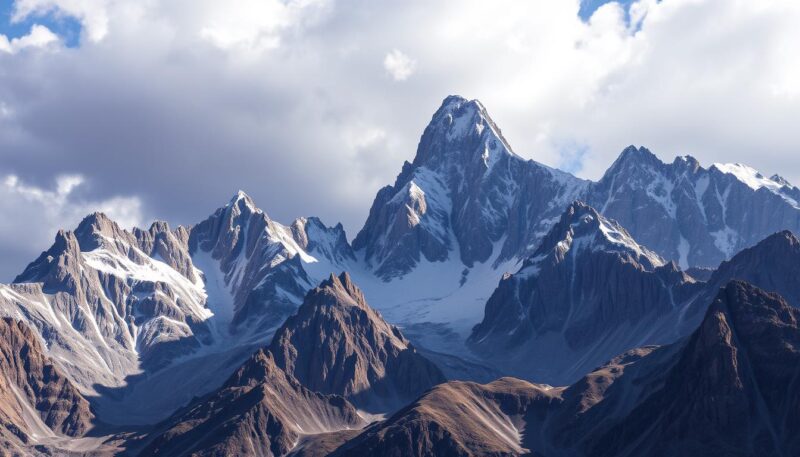Did you know Mount Olympus, Greece’s highest peak, stands at 2,917 meters (9,570 feet)? It’s famous not just for its height but also for being the gods’ home. Located in Thessaly and Macedonia, it’s a place of ancient stories, like Homer’s “Iliad” and “Odyssey.”
Since 1938, it’s been a national park and since 1981, a UNESCO Biosphere Reserve. It’s home to over 1,700 plant species and many unique animals. Every year, about 10,000 climbers try to reach its peaks. It’s a top spot for adventure and nature lovers, with many routes to explore.
Introduction to Mount Olympus
Mount Olympus is a famous landmark in Greece, known for its rich Greek mythology and stunning landscapes. This mountain has been a key part of stories for centuries. It is said to be the home of the Greek gods, especially Zeus.
Many stories see it as a paradise, unlike the chaotic world below.
Mythological Significance
In Greek mythology, Mount Olympus is more than just a mountain. It symbolizes the divine order. The ancient Greeks thought its top was peaceful and untouched by storms.
Myths tell of gods and heroes visiting this sacred place. They came to discuss human fates. This made Mount Olympus a central part of Greek stories.
Geographical Overview
Mount Olympus has 46 peaks over 2,000 meters, making it a breathtaking sight. The highest, Mytikas, is 2,917 meters tall, often hidden in clouds. It has lush forests, deep gorges, and diverse ecosystems.
Hikers love to explore its trails and see its natural beauty. This beauty supports a wide range of plants and animals. Archaeological finds in Dion show it has been sacred for ages, linking it to Greece’s culture.
Key Peaks of Mount Olympus
The peaks of Mount Olympus offer diverse adventures for climbing enthusiasts. Each peak has unique attributes and thrilling challenges. Mytikas Peak, Stefani Peak, and Skolio Peak are among the most notable.
Mytikas Peak
Mytikas Peak stands at an impressive 2,917 meters, making it the highest point in Greece. It’s the ultimate goal for many climbers. The climb combines non-technical hiking and Grade III scrambling.
The first successful summit was in August 1913. It marked a milestone in climbing history. Climbers are rewarded with stunning views from the top.
Stefani Peak (Zeus’s Throne)
Stefani Peak, at 2,909 meters, is famous for its mythological significance. It’s known as Zeus’s throne. Climbers are drawn to its reputation and the breathtaking views it offers.
As the second highest peak, it attracts both beginners and seasoned climbers. Its altitude and historical background make it appealing to those interested in Greek mythology and nature.
Skolio Peak
Skolio Peak reaches 2,911 meters, offering challenges for experienced rock climbers. Its northern face has well-known climbing routes that require technical skills. Climbing Skolio demands physical endurance and strategic planning.
It appeals to those seeking thrills and adventure. The distinct routes allow climbers to test their abilities while enjoying the stunning views.
Tourist Routes for Climbing Mount Olympus
Mount Olympus has many climbing routes for all skill levels. The Prionia Trail and the Gortsia Trail are especially popular. They offer stunning views and a chance for outdoor adventure.
The Prionia Trail
The Prionia Trail starts at 1,100 meters and connects to the E4 international path. It goes through the beautiful Enipea Canyon to the Spilios Agapitos Refuge. Climbing to Mytikas from here takes about six hours.
The trail has both easy paths and tough scree sections. It’s a great challenge for those seeking outdoor adventure.
The Gortsia Trail
The Gortsia Trail is less crowded and climbs gently to Skourta. It then reaches the Muses Plateau and Kakkalos Refuge. The trail’s moderate slope is a plus, but climbers should be ready for steeper parts near Stefani Peak.
Both trails are close to Litochoro village. This makes it easy to find places to stay and join guided treks. These treks can help improve your climbing skills.
Conclusion
Mount Olympus is a top spot for adventure tourism, thanks to its rich history and myths. It draws many visitors every year. The peaks, like Mytikas, Stefani, and Skolio, offer different climbing experiences for all levels.
This makes Mount Olympus a place where everyone can enjoy its beauty. It’s a welcoming spot for outdoor lovers.
The area’s natural beauty and tough terrains are just part of its charm. It’s also a UNESCO Biosphere Reserve, showing off a special ecosystem. This ecosystem needs our care to keep its biodiversity.
Visitors can have fun exploring while helping protect this amazing place. This is how Mount Olympus shows us how to enjoy nature and history together.
As more people want to travel sustainably, Mount Olympus is a great example. It teaches us to value nature and history. It inspires us to protect its beauty for the future.



